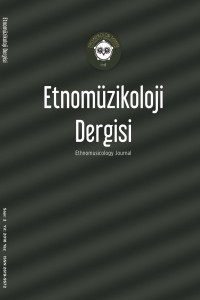Öz
When In 1987 a cultural functionary of the "Central Working Group on Dance Music" described heavy metal as the "current magic formula in popu- lar music" of the 1980s socialist East Germany, the German Democratic Re- public (GDR), it may be surprising that cultural politics is at all concerned with this musical phenomenon. The official further stated that heavy metal is a "legitimate part of the socialist music culture". This positive attitude to- wards metal is in general rather surprising in the 1980s, since the debate about heavy metal in Western countries was dominated by the so-called moral pan- ics (NACHWEIS). Unquestionably, in socialist East Germany heavy metal was a popular youth culture in the 1980s. At the same time, however, as an originally Western youth culture it was quite problematic. The quoted ex- pression therefore reflects a general change of heart in the second half of the 1980s and the attempt to accept and integrate the popular youth culture with the aim to not lose the connection to youth completely. However, this did not mean that heavy metal and its fans could develop freely in the GDR.
Kaynakça
- Böhm, Anja. (1985, March). “Schwer, Hart und Wild: Heavy Metal” (Teil I) / Heavy, Hard and Wild: Heavy Metal (part one). Melodie & Rhythmus, 3(1985), 14–15.
- Breitenborn, Uwe. (2010). Bombenhagel und Eiserner Vorhang. Heavy-Metal- Subkultur im Staatsradio / Hail of Bombs and Iron Curtain. Heavy Metal Subculture on the State Radio. Heißer Sommer – Coole Beats: Zur populären Musik und ihren medialen Repräsentationen in der DDR / Hot summer – cool beats. On popular music in the GDR’s meda. Ed. by Sascha Trültzsch and Thomas Wilke. Frankfurt/Main: Lang, 105–18.
- BSTU (2015). Grundsatzdokumente. Befehl 11/66 / Fundamental documents. Order 11/66. <http://www.bstu.bund.de/DE/Wissen/MfS-Dokumente/ Downloads/Grundsatzdokumente/befehl-11-66_bekaempfung-jugend.pdf? __blob=publicationFile>. Accessed 1 April 2015.
- Fulbrook, Mary. (2005). The People’s State: East German Society from Hitler to Honecker. New Haven: Yale University Press.
- Gienow-Hecht, Jessica. (2010). Cold War Culture. The Cambridge History of the Cold War, vol. 1. Ed. by Melvyn P. Leffler and Odd Arne Westad. Cam- bridge: University Press, 398–418.
- Giesecke, Jens. (2011). Die Stasi 1945–1990 / The Stasi 1945-1990. München: Pan- theon.
- Kahn-Harris, Keith. (2007). Extreme Metal. Music and Culture on the Edge. Oxford: Berg.
- Kowalczuk, Ilko-Sascha. (2009). Endspiel: Die Revolution von 1989 in der DDR / ‛end game: the revolution of 1989 in the GDR’. Bonn: bpb.
- Larkey, Edward. (2000). A Sound Legacy? Music and Politics in East Germany, Washington.
- Levine, Mark. (2009). Headbanging Against Repressive Regime: Censorship of Heavy Metal in the Middle East, North Africa, Southeast Asia and China. Copenhagen: Freemuse.
- Martin, Wolfgang. (1985, August). Musik Special. Heavy metal. Neues Leben, 8(1985), 8–9.
Öz
When In 1987 a cultural functionary of the "Central Working Group on Dance Music" described heavy metal as the "current magic formula in popu- lar music" of the 1980s socialist East Germany, the German Democratic Re- public (GDR), it may be surprising that cultural politics is at all concerned with this musical phenomenon. The official further stated that heavy metal is a "legitimate part of the socialist music culture". This positive attitude to- wards metal is in general rather surprising in the 1980s, since the debate about heavy metal in Western countries was dominated by the so-called moral pan- ics (NACHWEIS). Unquestionably, in socialist East Germany heavy metal was a popular youth culture in the 1980s. At the same time, however, as an originally Western youth culture it was quite problematic. The quoted ex- pression therefore reflects a general change of heart in the second half of the 1980s and the attempt to accept and integrate the popular youth culture with the aim to not lose the connection to youth completely. However, this did not mean that heavy metal and its fans could develop freely in the GDR.
Kaynakça
- Böhm, Anja. (1985, March). “Schwer, Hart und Wild: Heavy Metal” (Teil I) / Heavy, Hard and Wild: Heavy Metal (part one). Melodie & Rhythmus, 3(1985), 14–15.
- Breitenborn, Uwe. (2010). Bombenhagel und Eiserner Vorhang. Heavy-Metal- Subkultur im Staatsradio / Hail of Bombs and Iron Curtain. Heavy Metal Subculture on the State Radio. Heißer Sommer – Coole Beats: Zur populären Musik und ihren medialen Repräsentationen in der DDR / Hot summer – cool beats. On popular music in the GDR’s meda. Ed. by Sascha Trültzsch and Thomas Wilke. Frankfurt/Main: Lang, 105–18.
- BSTU (2015). Grundsatzdokumente. Befehl 11/66 / Fundamental documents. Order 11/66. <http://www.bstu.bund.de/DE/Wissen/MfS-Dokumente/ Downloads/Grundsatzdokumente/befehl-11-66_bekaempfung-jugend.pdf? __blob=publicationFile>. Accessed 1 April 2015.
- Fulbrook, Mary. (2005). The People’s State: East German Society from Hitler to Honecker. New Haven: Yale University Press.
- Gienow-Hecht, Jessica. (2010). Cold War Culture. The Cambridge History of the Cold War, vol. 1. Ed. by Melvyn P. Leffler and Odd Arne Westad. Cam- bridge: University Press, 398–418.
- Giesecke, Jens. (2011). Die Stasi 1945–1990 / The Stasi 1945-1990. München: Pan- theon.
- Kahn-Harris, Keith. (2007). Extreme Metal. Music and Culture on the Edge. Oxford: Berg.
- Kowalczuk, Ilko-Sascha. (2009). Endspiel: Die Revolution von 1989 in der DDR / ‛end game: the revolution of 1989 in the GDR’. Bonn: bpb.
- Larkey, Edward. (2000). A Sound Legacy? Music and Politics in East Germany, Washington.
- Levine, Mark. (2009). Headbanging Against Repressive Regime: Censorship of Heavy Metal in the Middle East, North Africa, Southeast Asia and China. Copenhagen: Freemuse.
- Martin, Wolfgang. (1985, August). Musik Special. Heavy metal. Neues Leben, 8(1985), 8–9.
Ayrıntılar
| Birincil Dil | İngilizce |
|---|---|
| Bölüm | Araştırma Makaleleri |
| Yazarlar | |
| Yayımlanma Tarihi | 30 Eylül 2018 |
| Gönderilme Tarihi | 1 Haziran 2018 |
| Yayımlandığı Sayı | Yıl 2018 Sayı: 2 |


